CUT 7: The Mystique and Legacy of Racing E-types with Unique Plates
Not clones, not replicas – these two E-types have parallel and equally compelling histories
Lyndon Mcneil
Rather like today’s superstar footballers and musicians – so famous they’re known only by their first names – the most successful and celebrated GT cars competing in the UK in the late 1950s and early ’60s tended to be known not by their model names, but by their registration plates.
If you’re schooled in that golden era, many spring to mind. Essex Racing’s glorious Aston Martin DB4 GT Zagato duo of ‘1 VEV’ and ‘2 VEV’ are fine examples. As are the brilliant ‘BUY 1’ and ‘OWN 1’ plates sported by assorted competition Jaguars fielded by racer (and Jaguar dealer) John Coombs. However, when it comes to evocative registration plates few carry more mystique and kudos than ‘CUT 7’.
Associated with not one, but three successive – and successful – competition E-types, the CUT 7s were built to specifications that strayed from those of the factory built cars. Like all racing cars they were developed and evolved to generate more pace through performance enhancements and weight savings, but the CUT 7s also had panache and charisma that set them apart. The registration number and striking colour scheme played their part, but the cult of the CUT 7 cars was as much to do with the fascinating man who built and raced them. That man was Elmer Richard ‘Dick’ Protheroe.
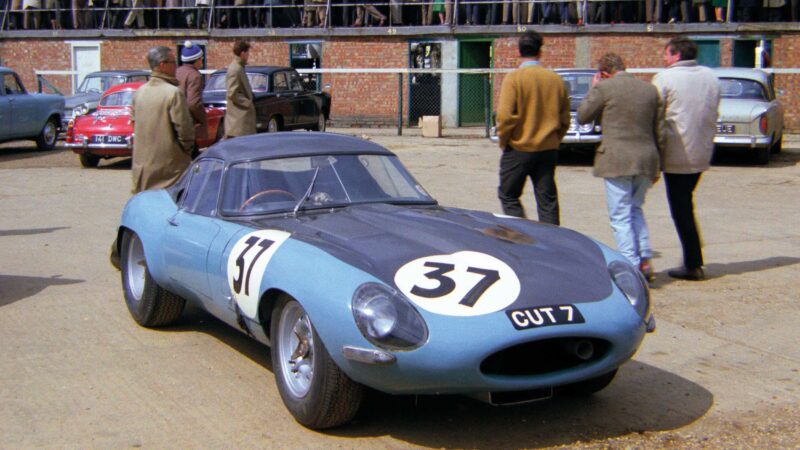
Dick Protheroe’s lightweight-spec third CUT 7 evolution in the Silverstone paddock in May, 1964.
Like many of his generation, Protheroe (born in 1922) was an exceptional individual. A decorated wartime pilot in RAF Bomber Command, he flew Wellingtons and Lancasters before completing his operational flying with the Pathfinder Squadron. His post-war flying career was no less impressive, and included three years as a test pilot and training aircrews to fly the new Vickers Valiant and Handley-Page Victor ‘V’ bombers.
Protheroe was also a keen driver, and used his meagre wartime petrol rations to fuel a tasty variety of pre-war sports cars, among them a number of MGs, a supercharged Austin 7 and a rather splendid Bugatti Type 37. However it wasn’t until 1952, while serving with the RAF in Egypt, that Protheroe acquired his first Jaguar. And not just any old Jaguar, but one of the first alloy-bodied XK120s, which he modified and raced at local motor club events before bringing the car back to the UK the following year.
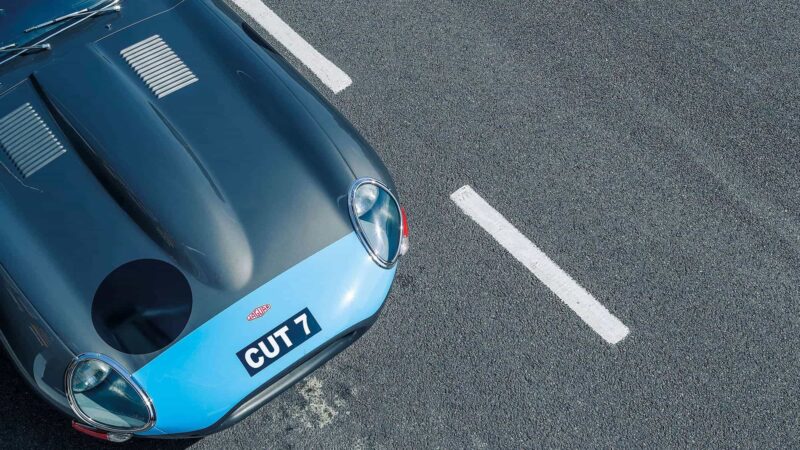
This car was based on Jaguar’s own low-drag development car, which spawned the factory Lightweights
It was from this point he went racing in earnest, continually developing his XK120 – by now nicknamed the ‘Ancient Egyptian’ – over the next few seasons and making a name for himself against established stars like Mike Hawthorn and Duncan Hamilton. This led to a spell driving Jaguar-powered sports cars for Tojeiro and HWM, but Protheroe returned to his own self-run XK120 in 1959, subsequently acquiring two further examples that were raced in 1960 and 1961. The latter of these was fitted with a 3.8-litre engine, carried the registration plate ‘CUT 6’ and had sufficient pace to beat the then brand-new E-types. At least for a while.
Despite his success the canny Protheroe knew the end was nigh for the XK, so acquired one of the first E-type coupés during 1961 with a view to developing it for the ’62 season. Equipped with an engine fitted with D-type wide-angle heads and Weber carbs, plus improved suspension, brakes and the new ‘CUT 7’ registration number, it ran successfully in all the national and international races of that year. One highlight was Goodwood, where it finished a highly creditable sixth in the TT against works Ferrari GTOs, factory-supported E-types and DB4 GT Zagato Astons.
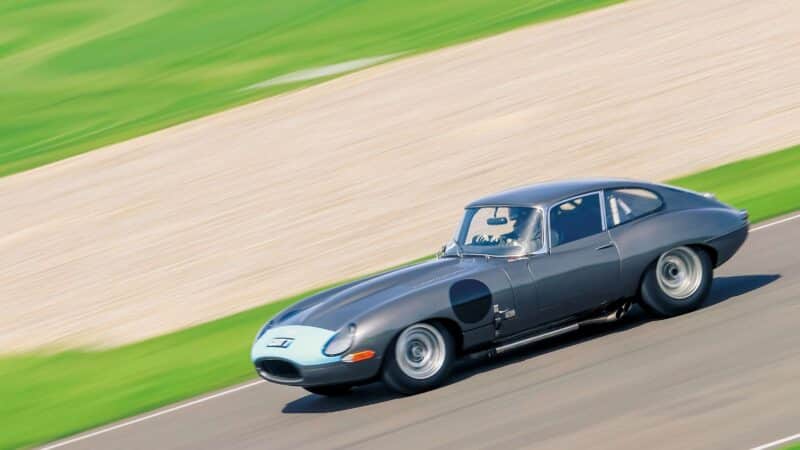
The visual differences between the two generations of CUT 7 are subtle. Flared air intakes on the flanks
Lyndon Mcneil
Still Protheroe was restless. He knew the E-type needed to shed weight if it was to fulfil its potential, and was already formulating plans for further improvements to be incorporated into his next car. With excellent contacts at Jaguar via Lofty England, Protheroe enquired as to his options for ’63, but was told there would be nothing more suitable for racing.
Duly advised, Protheroe decided to order his next E-type in component form so that he could build the second CUT 7 to his desired specification. That’s to say less weight, more power and better cooling for rear axle and brakes. Such was its bespoke nature it even carried its own model designation and bespoke chassis number: DP138-D5. As the start of ’63 approached it’s easy to picture Protheroe feeling rather optimistic. Painful, then, to imagine his dismay on arriving at the first race to find the factory had spent the winter rebuilding chassis S850006 (reg ‘4WPD’) into the first Lightweight E-type.

Give away v2, which is closer to true Protheroe spec than the highly tuned v1, below
Lyndon Mcneil
Unfortunately for Protheroe, the weekend would get a whole lot worse, as an extract from his biography describes: “The first race of ’63 was the March Snetterton meeting, which took place in pouring rain. When lying third behind Innes Ireland and Graham Hill (in the new lightweight E-type) at about three-quarter distance I lost it in the biggest possible manner at 6200rpm in top at the end of the Norwich straight. After three rolls I came to rest on the inside of the circuit, somewhat bruised but in one piece, just in time to see the two following cars repeat the process… In 10 days the car was completely stripped and rebuilt and appeared at Goodwood on Easter Monday, where I had the privilege of being lapped by two Lightweights! At the May Silverstone meeting I came in third after Mike Parkes had obligingly attacked a bank. By this time the irrefutable fact had emerged – I was once again in an outclassed motor car in international GT racing.”
Close links or not, Protheroe must have been vexed by the ‘surprise’ appearance of factory Lightweights. He quickly acquired the lightweight low-drag development car from Jaguar’s Experimental Department as the basis for his third and final CUT 7 E-type, suggesting he expressed his displeasure to Lofty in no uncertain terms.
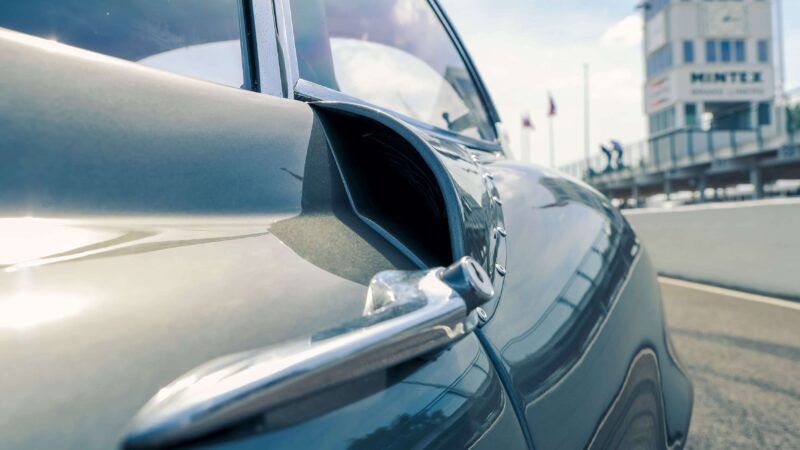
Give away v2, which is closer to true Protheroe spec than the highly tuned v1, below
Lyndon Mcneil
So what became of the first two CUT 7s? Well, the original was sold by Protheroe as a road car, although it eventually found its way back into racing. By contrast Protheroe sold the second CUT 7 as a racer (albeit re-registered as ‘256 DJU’) to Roger Mac, who enjoyed immense success in the car at national level, including a hot streak of seven wins from seven race meetings. David Cunningham then owned and raced it in 1964, again with great success, before selling it to Paul Vestey and Richard Ward, who fared well with it in 1965.
“You could see where Protheroe’s boys had thrashed the chassis with a hammer and hit it with a chisel”
In 1966 the car suffered damage to the front of the chassis in a testing crash, so Vestey and Ward used the opportunity to rebuild the car around a new semi-lightweight roadster tub. It then enjoyed a new lease of life, becoming one of the most successful and well-known E-types during the ’80s and ’90s. Meanwhile, the damaged original Protheroe coupé monocoque had been sold to Jaguar employee Dick Soans, who quickly sold it to Penny Woodley in 1968. She used it as a hillclimb car and retained ownership until 2015, when she sold it to Jonathan Lewis. Still with me? Good!
It’s at this stage that historic racer and self-confessed Protheroe anorak Richard Meins enters the frame. Having owned the first CUT 7 E-type for some years and raced it regularly at the Goodwood Revival, Meins agreed a deal with Jonathan Lewis to buy both the souped-up semi-lightweight and the ratty but remarkably unmolested ex-Woodley hillclimber in order to restore the second CUT 7 to its former glory without there being any doubt about its provenance or identity.
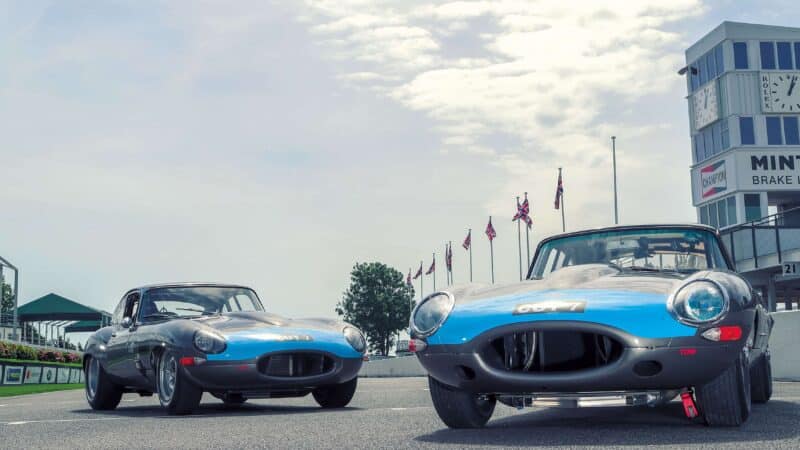
Together, for the first time. As they were concurrently built cars, the first and second generation of CUT 7 had never shared the same piece of Tarmac. V1 sits to the left with its flared arches
Lyndon Mcneil
This was the start of a unique and painstaking restoration that has led us to this point: standing in the sunshine at Goodwood as CUT 7 v1 and CUT 7 v2 are arranged on the start-finish straight for the benefit of a Motor Sport photo shoot.
It’s remarkable and just a little strange to consider that because all three CUT 7s were concurrent cars – that’s to say Dick Protheroe sold one to build the next – the first and second iterations have never before sat together in the Goodwood paddock. In rolling them out onto the start-finish straight we’ve created a small piece of history. Understandably it’s quite a moment for Meins, who’s in reflective mood as he stands gazing at his two fabulous cars: “I just think the whole Protheroe story is amazing. The way he started with the XKs, then got into early E-types and was fighting Ferraris and the factory Lightweight E-types by doing things his own way. The TT grid here in ’62 was just amazing, and there was Dick and his CUT 7, right in the thick of it.
“My connection to the CUT cars started almost by accident. I was looking to get out of racing in historic F1 at the time, and I’d decided I wanted to get a Jaguar. No specific car, just a good one with the credentials to get me into the right events. It just so happened that the first CUT 7 came up around that time. I didn’t know much about the Protheroe story then, but I did my research. The more I learned about him the more I got into the fantastic story behind the cars. Of course when the second car came up I’d become something of a Protheroe anorak, so I couldn’t really pass up the opportunity to get it!”
Meins entrusted the project to Jaguar race preparation expert Valley Motorsport (VMS). It was a logical move, as Nigel Morris and his team were already looking after the first CUT 7. One of the VMS crew closely involved in the project is Tom Adams, who takes up the story: “We knew Richard believed it was vital that the car’s provenance was preserved and respected. When we picked it up from Jonathan Lewis he said to me that the tub and body were really original, but it was hard to see all the clues we were looking for. Prior to Jonathan having the car, it had been owned by Penny Woodley from 1968 right through until 2015. She had it sat there as a hillclimb car, so hadn’t done much to it. When we got it back to the workshops we stripped it down, acid-dipped it and had Pat Wells – the original Protheroe mechanic – come and look at it. He identified all the brake ducts and other tweaks that they’d done to it.
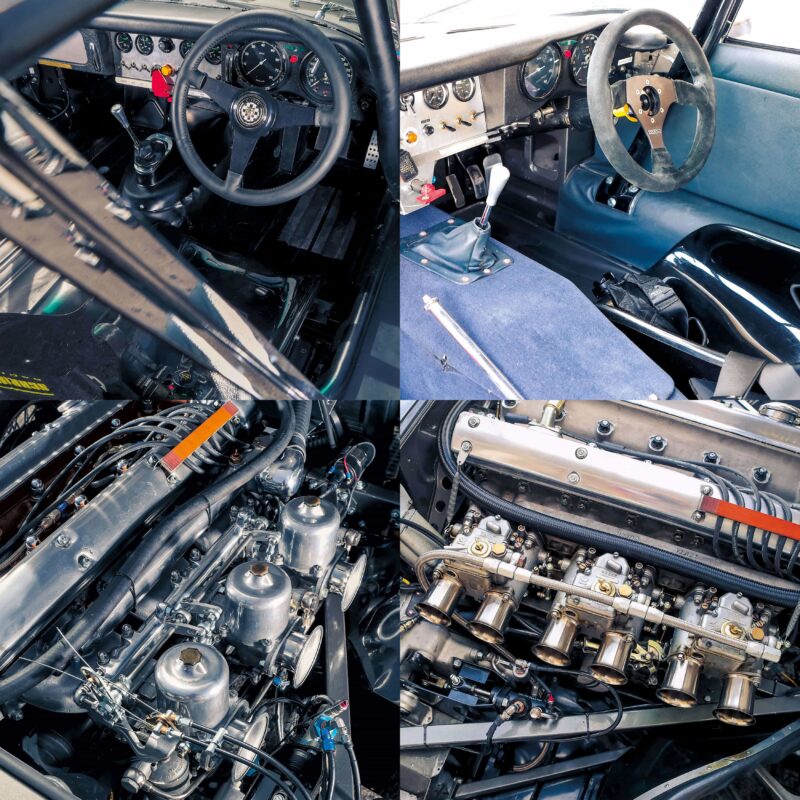
Both CUT 7s, but to different specs. On the left sits the more standard interior and engine of v2, whereas to the right is v1, with its engine featuring D-type heads and triple Webers instead of SU carbs
Lyndon Mcneil
“Normally we rebuild E-types and they’re all the same, but this one had so many alterations. Protheroe always had a thing about fitting a big plexiglass panel in place of the tailgate to save weight and increase rearward visibility. At some stage this had been removed and retro-fitted with a regular tailgate, but we could see where they’d welded up the brake duct holes to reinstate the tailgate hinges.
“After we’d dipped it we stood back, looked at all the modifications to the floor and body panels and said we literally couldn’t touch any of this! You could see where Protheroe’s boys had thrashed it with a hammer and hit it with a chisel to make the holes in the floor. The crossmember where the gearbox sits had been chopped out and a tube fitted in there.
“A modern preparation mindset makes it very hard for us not to immediately jump in and replace sections of floor or put the crossmember back, but Richard was insistent we left all of that. Consequently I think this car is very special. It’s terrific to look at it and say, ‘This tub is the tub modified by Protheroe in 1962/63.’ The authenticity is plain to see.”
Meins isn’t just here for our benefit, he’s come for some pre-Revival testing: CUT 7 v1 ready for the TT Celebration; CUT 7 v2 for its very first shakedown and some prep prior to its debut in the Kinrara Trophy. I’d be happy just to watch the day unfold and see the CUT 7 cars in action, but once Meins and his racing partner, Rob Huff, have tried the cars I’ll be suiting-up and having a go. Quite a day, then.
Of Meins’ brace of CUT 7s, the first has a comprehensively evolved specification that takes it some way beyond that which Protheroe built it over the winter of 1961. In fact with wide arches, bigger brakes, peg-drive alloy wheels and a full aluminium engine with the fabled D-type wide-angle heads, it’s the spec of which Protheroe would have dreamed! This then is the other kind of authenticity. The sort that reflects a competition history that extended way beyond its first few seasons.
Meins could have put it back to its narrow-bodied, wire-wheeled 1962 TT spec, but not only would this deny its later history, but it would also render it easy meat for the Cobras that are now so difficult to beat in the Revival’s blue riband TT Celebration race.
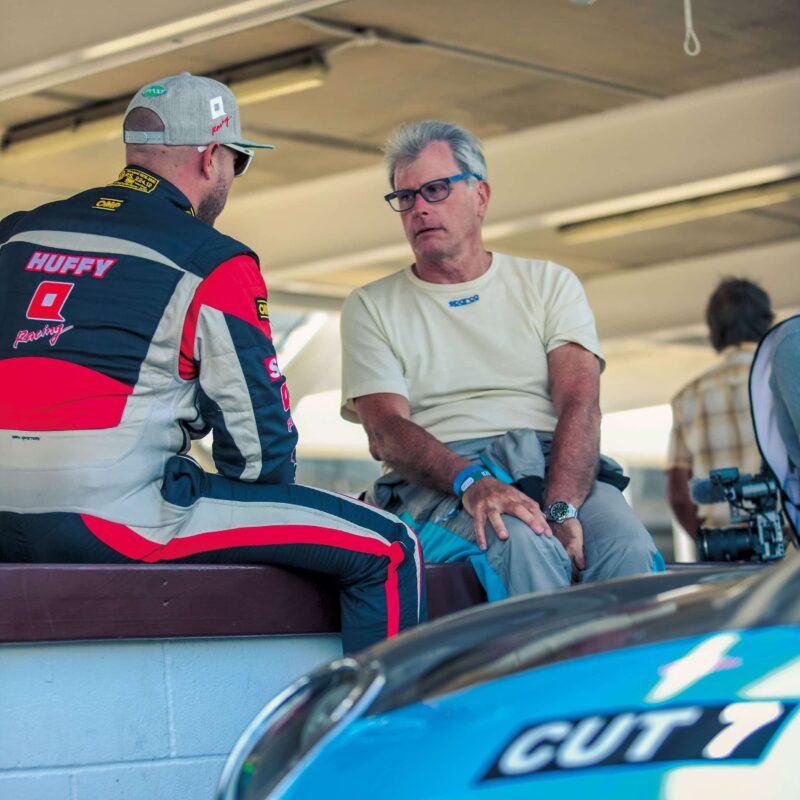
Custodian of the CUT 7s, Richard Meins, and World Touring Car star Rob Huff converse ahead of the Goodwood Revival.
The second car – the one we’ve really come to pore over – is much the closer to its original Protheroe spec. Visually it is just as it would have been at the start of 1963, and of course it sports that quirky and almost entirely original tub, as modified at Protheroe’s workshops back in 1962/63. On first glance you simply see an E-type, albeit one that doesn’t look quite as you expect. Closer inspection reveals a number of changes, the most obvious are the blistered air intake ducts that sit proud just aft of the B-pillars, followed by two oblong exit holes in the C-pillars. There’s another pair of holes where the standard tail lights would be and, of course, Protheroe’s trademark plexiglass panel in place of the heavy tailgate. The more you look the more there is to love.
The only significant changes to its period spec are those to make it eligible to race in the pre-63 Kinrara Trophy. That’s to say swapping the wide-angle D-type head, tubular manifold and triple Webers favoured by Protheroe for the heavier steel bonnet, regular cylinder head, SU carbs and a cast exhaust manifold demanded by historic racing’s period-specific regs.
While there would be a certain satisfaction in seeing these cars in time-warp condition, just as Protheroe built them, it would mean they were also museum pieces. Better, surely, to preserve them, but also race them? And hard. As their creator intended.
Meins and Huff spend the morning putting miles on the cars. They look and sound magnificent: v1 bristling with a swagger that can’t be faked; v2 with the pristine aura of a freshly restored car that has yet to be bloodied in battle. Both are the very essence of GT racing in the Sixties.
“It’s amazing that one man and a few mechanics could hope to rival the factory”
You don’t so much climb into an E-type as persuade yourself through the tight door aperture. It’s a squeeze to get in, but once you’re there it’s reasonably roomy, slung low in your seat with legs out straight, arms comfortably crooked and steering wheel just the right distance from your chest. It’s easy to imagine Protheroe tucked in here, checking the array of Smiths dials set into the distinctive metal dash and staring through the upright windscreen and out over the endless bonnet, hunting down the factory Lightweight E-types and the odd works Aston or Ferrari.
Of the pair, CUT 7 v2 is a softer, sweeter, less edgy machine. The motor has a lovely spread of low- and mid-range performance, but there’s none of the D-type-spec motor’s top-end punch. It doesn’t quite have the howl or snort, either, thanks to the SU carbs and cast exhaust manifold, but the noise still has that unmistakable timbre that can only be a Jag straight-six – as much a part of Britain’s iconic internal combustion playlist as a Rolls-Royce Merlin.
Given this is the first day v2 has been driven in anger I should probably be feeling a bit tense, especially as Goodwood is such a fast and unforgiving circuit, but it takes less than a lap to relax into the car and enjoy it to the full. Where CUT 7 v1 has a deliberately purposeful, no-nonsense edge to its dynamics, v2 is really progressive and approachable. I have no doubts it would share v1’s pricklier personality if it were built to TT spec, but in toning things down for pre-63 eligibility and a slot on the Kinrara Trophy grid, Meins has got himself an E- that’s unquestionably quick, and one that’s readily exploitable and fabulously feelsome.
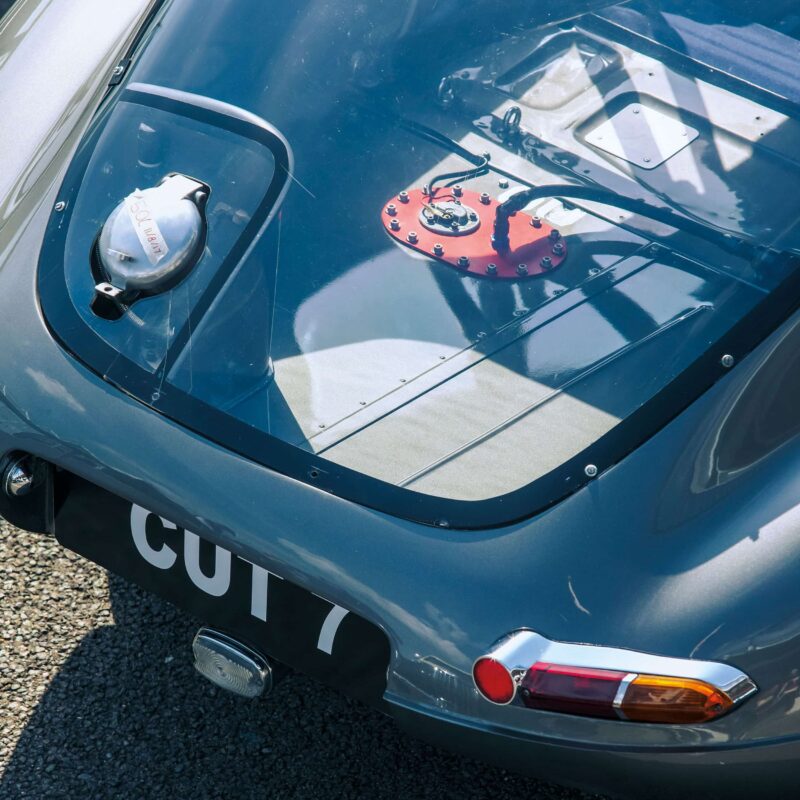
The signature Protheroe plexiglass of v2
The way it slides is particularly satisfying, for compared to the grippier, stiffer TT-spec car it gives you plenty of warning. You feel ahead of the car rather than behind it, predicting its next move rather than reacting to it. Huff has honed v1’s handling to make it a faster car over the last few seasons, but that speed requires skill to extract – something you can see in the way he wrings its neck around Goodwood. Nevertheless he loves the way v2 delivers its lap time in a more benign manner. Meins, who has worked hard to develop his driving and get on top of the TT car’s more demanding nature, is immediately smitten by v2’s Kinrara set-up, as much for the contrast it offers as the pure enjoyment it delivers. Both cars are wonderful things to drive, but I have to say for pure pleasure the milder-mannered v2 is an absolute gem.
It seems amazing to think one man and a handful of mechanics could hope to develop their own racing E-type to rival that of Jaguar’s own Competition Department, let alone Ferrari. Yet not only did Protheroe relish the challenge, he steered his cars to considerable success against the established stars in their factory-run cars.
The fact that his story still captivates the imagination (tragically, Protheroe was killed while testing a Ferrari 330P ahead of the RAC Tourist Trophy at Oulton Park in 1966) is testament to the exploits of an exceptional individual.
And the cars? Seeing two of the most fascinating E-types ever raced still in action at Goodwood is the best possible memorial to a true character of British motor racing.
Taken from Motor Sport, January 2018